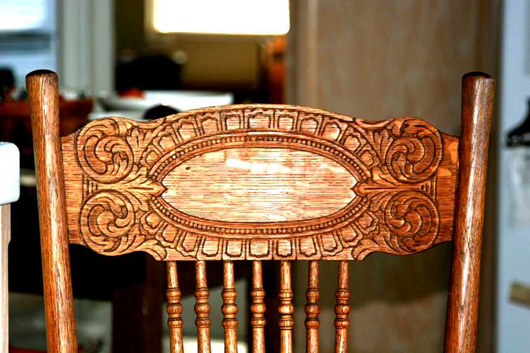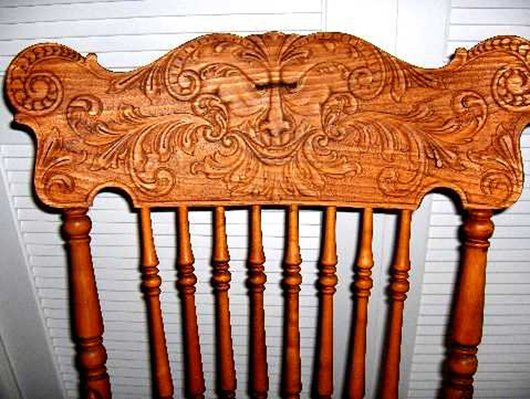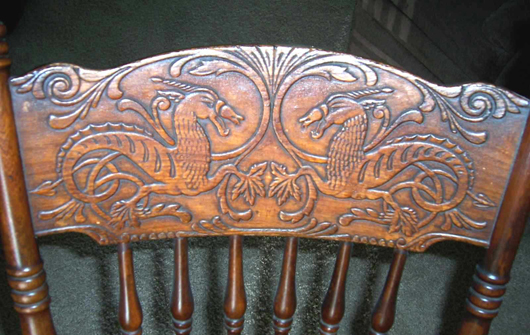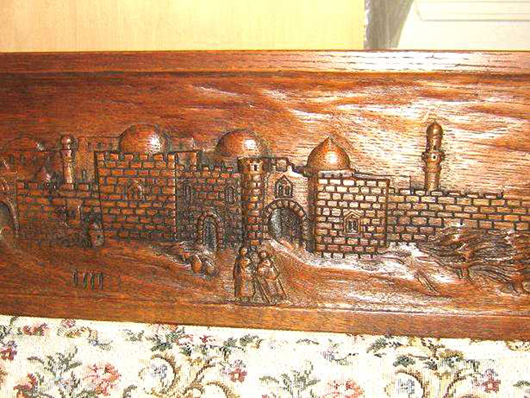In a recent antiques publication an author gave a master lesson in carving a 17th century “Sunflower” chest. In explaining the ins and outs of New England Colonial carving he highlighted the real world priorities of the period and the fact that decorating an otherwise perfectly fine plain chest was a luxury few could afford to buy or had the time to produce. But he then explained that since the Sunflower chests all had certain constants such as panel size, stile design and trim dimensions, it was actually possible for the turner and the joiner and the carver to stockpile basic elements of the chests for use when the demand arose.
While that is not exactly production line work, it is the beginning of an industrial mind-set that reached into deeper and firmer ground with its roots as the next two centuries rolled by in Colonial/Federal America. The urge to decorate plain surfaces appears to be a universal human trait that appeals to the “art” in all of us.
The replication of effort in difficult tasks in the cabinetmaker’s shop is what allowed large true sets of chairs to be turned out in the 18th century, and by the early 19th century entrepreneurs like Lambert Hitchcock really did produce furniture in an assembly-line manner with each worker performing the same task repetitively on endless lines of chairs. Even the decorations were “by the numbers” with stencils producing the same cornucopia thousands of times on the crest rails of thousands of chairs.
By mid century J.H. Belter had nearly a hundred German woodworkers and carvers in his factory located next to his rooming house in Manhattan, and the Meeks brothers had a new factory nearby and even had an outlet in New Orleans. But even with all the labor and all those tools and factories, it was still relatively expensive and time-consuming for Belter to turn out a parlor set in “Rosalie Without the Grapes” or for Meeks to order up a five-piece “Stanton Hall” set. But the desire for decoration was still there and as long as somebody could afford it.
By the turn of the century things had changed both in society and in the factory. Despite some ups and downs the decades after Civil War were prosperous and America’s population was growing both in numbers and in wealth. And those wealthier citizens were willing to pay for a little decoration in their lives—within reason.
The mail-order catalog phenomenon was in full swing and was the primary furniture distributor of the period and price was the key. How could Sears or Larkin produce decorative furniture to compete with the intricate carvings of the mid century? No one wanted to pay that much or wait that long.
They didn’t have to. In the very late 1800s along came a process that could produce elaborate designs on chair parts for a cost of next to nothing. It even had a lot of people thinking it was hand carved. The process? The steel die stamp. A design with sharp edges was etched into a metal plate. That plate was mounted on a roller and under great pressure was passed over a waiting chair crest rail that had been precut to shape and steam-bent to match the curve on the roller. The result was a perfect impression of the etching that was literally pressed into the wood giving the effect of a three-dimensional carving. Thus began the great era of the “press back” chair in American furniture.
In the simplest case a rather shallow design was pressed into the waiting crest and without further ado was mounted to a chair ready to be finished. That allowed a mail-order house like Sears to offer a dining chair in 1902 for $.63 that had “handsome carving” on the back. Other chairs were enthusiastically—and erroneously—described as having “rich hand carving,” “beautifully turned and carved back,” or simply a “richly carved back.” Maybe the catalog writers didn’t know about “the process.”
Here a few examples of press back chairs along with a few that are combinations of pressing and hand chasing and a few that are not press backs, but are from the same period.
Cheap – This chair has a shallow pattern that required single pass of the die on the birch crest. This was simply a decorative touch and made no real effort to look hand carved. This was a very inexpensive chair at the time. 
Larkin – A design with a little more depth and texture but still a fairly simple look is shown in this Larkin chair that was offered in 1908 for $.25 and one Larkin certificate or in a set of four for five certificates with no cash payment. 
HW – The Heywood Brothers and Wakefield Co. offered this chair around 1900 that showed a good, deep design with stiles topped by Victorian era “honey dipper” finials. 
Face – The “face chair” movement was a prime beneficiary of the press back technology. Mythological creatures could now be instantly transferred to chair backs without all that tedious carving.
Dragons – Of course the other main movement of the period, the “creature feature,” worked its way into the press back theme book. These two dragons are about to mix it up.
Griffins – The two figures on this back are traditional winged griffins that have been pressed into service. 
Hand chased – The Holy Land scene on an otherwise severely plain Mission-style chair was first pressed, then followed by hand chasing that removed background material and left visible tool marks to enhance the notion of hand carving. 
Windmill – The outline of these happy cloggers may have been pressed but the main work was indeed hand carved. 
Not pressed – This may appear to be a press back candidate but the bottlenose dolphins are true carvings applied over the quartersawn veneer. 
Send your comments, questions and pictures to Fred Taylor at P.O. Box 215, Crystal River, FL 34423 or email them to him at info@furnituredetective.com.
Visit Fred’s website at www.furnituredetective.com. His book How To Be a Furniture Detective is available for $18.95 plus $3 shipping. Send check or money order for $21.95 to Fred Taylor, P.O. Box 215, Crystal River, FL 34423.
Fred and Gail Taylor’s DVD, Identification of Older & Antique Furniture ($17 + $3 S&H) is also available at the same address. For more information call 800-387-6377, fax 352-563-2916, or info@furnituredetective.com. All items are also available directly from his website.


